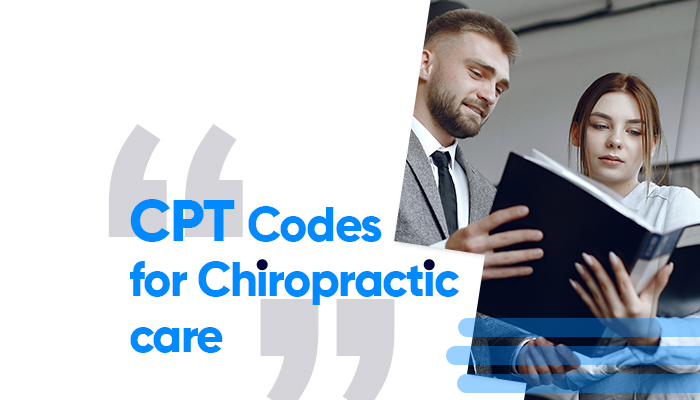Chiropractic services improve musculoskeletal health and well-being. However, billing and coding could be challenging for chiropractors and other medical staff professionals.
Effective billing and coding are essential for accurate and timely reimbursement, insurance regulations compliance, and a thriving chiropractic practice. By ensuring proper documentation and adherence to coding guidelines, chiropractors can optimize their revenue cycles and minimize the risk of claim denials or audits.
This article covers chiropractic billing and coding best practices and the most typical medical billing and coding systems.
Let’s start right away!
Primary analysis of the patient CPT codes – Chiropractic care
99201: This code denotes an office or outpatient new patient evaluation and management visit. It typically involves minimal complexity and a brief face-to-face encounter between the healthcare provider and the patient.
99202: This code represents an office or outpatient visit for evaluating and managing a new patient, lasting between 15 and 29 minutes. It involves a slightly more complex assessment and extended face-to-face interaction compared to 99201.
99203: This code represents an office or outpatient visit for evaluating and managing a new patient, lasting between 30 and 44 minutes. It indicates a moderate level of complexity in the review and a more comprehensive assessment of the patient’s condition.
99204: This code represents an office or outpatient visit for evaluating and managing a new patient, lasting between 45 and 59 minutes. It suggests a high level of complexity in the assessment and a detailed examination of the patient’s condition.
99205: This code represents an office or outpatient visit to evaluate and manage a new patient lasting 60 minutes or more. It indicates the highest level of complexity in the review and a thorough assessment of the patient’s condition.
Also read: The Most Frequently Used CPT Codes in Dermatology
Subsequent visits chiropractic CPT codes
99211: This code represents an office or other outpatient visit to assess and manage an established patient requiring minimal physician work. It is typically used for brief encounters involving limited evaluation or intervention, such as simple follow-up or nurse visits.
99212: This code describes an office or other outpatient visit for assessing and managing an established patient that lasts between 10 and 19 minutes. It implies a slightly more complex encounter than 99211, with a longer duration and potentially involving additional evaluation or treatment.
99213: This code is for an office or other outpatient visit for the assessment and management of an established patient, specifically lasting around 20 minutes. It represents a moderate complexity encounter, where the healthcare provider spends more time evaluating and managing the patient’s condition.
99214: This code describes an office or other outpatient visit for the assessment and management of an established patient, lasting 25 minutes or more. It indicates a higher level of complexity compared to the previous codes, with a longer duration of the encounter and more comprehensive evaluation and management.
99215: This code represents an office or other outpatient visit for the assessment and management of an established patient that lasts 40 minutes or more. It is used for the most complex and time-intensive encounters, involving a thorough review, extensive control, and potentially multiple treatment modalities.
Under chiropractic manipulative treatment procedures
Here are the common CPT codes under chiropractic manipulative treatment procedures:
98940: This code refers to chiropractic manipulation in one to two spinal regions. The chiropractor applies techniques and modalities to those areas to improve joint and neurophysiological function.
98941: This code represents chiropractic manipulation in three to four spinal regions. The chiropractor applies various techniques and modalities to these regions to influence joint and neurophysiological function.
98942: This code indicates chiropractic manipulation in five spinal regions. The chiropractor applies different techniques and modalities to influence joint and neurophysiological function in these regions.
98943: This code covers chiropractic manipulation in one or more extraspinal regions. The chiropractor uses manipulation methods on places outside of the spine, such as the extremities (like the arms and legs) or other joints in the body.
Best practices for billing and coding for chiropractic care:
Best chiropractic billing and coding practices can improve the likelihood of timely and appropriate reimbursement. Here are some important considerations:
- Use the Correct Codes
- Document Medical Necessity
- Accurate Documentation
- Compliance with Coding Guidelines
- Stay Up-to-Date with Coding Changes
- Ongoing Education and Training
- Regular Auditing and Monitoring
Conclusion
In conclusion, billing and coding for chiropractic therapy can be complicated. However, it may be made a lot simpler with the correct information and tools. Thanks to this thorough guide, you now have the knowledge and tools you need to comprehend the billing and coding procedure for chiropractic therapy. With this information, you can easily navigate the billing and coding process and guarantee that the chiropractic service you get is accurately billed and coded.










